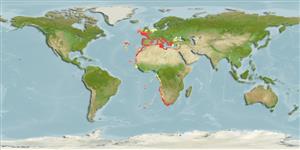Common names from other countries
Environment: milieu / climate zone / depth range / distribution range
Ecologie
; diepteverspreiding 3 - 871 m (Ref. 78235), usually 50 - 450 m (Ref. 8). Subtropical; 58°N - 41°S, 35°W - 38°E
Eastern Atlantic and the Mediterranean: from Ireland to Senegal, including the Azores and Canary Islands, and the entire Mediterranean. Temperate to tropical.
Length at first maturity / Size / Gewicht / Leeftijd
Maturity: Lm ? range ? - ? cm Max length : 11.2 cm TL mannelijk/geslacht niet bekend; (Ref. 8)
Known from pelagic depths between 100 to 200 m (Ref. 92299). Occurs on muddy and sandy bottoms on the shelf and upper slope. Buries in the mud during the day and emerges at night (Ref. 80202). Feeds on benthic invertebrates living on soft bottom substrates like polychaetes, bivalves, gastropods and echinoderms (Ref. 106588).
Life cycle and mating behavior
Geslachtsrijpheid | Voortplanting | Kuitschieten | Eieren | Fecundity | Larven
Members of the order Decapoda are mostly gonochoric. Mating behavior: Precopulatory courtship ritual is common (through olfactory and tactile cues); usually indirect sperm transfer.
Holthuis, L.B. 1980. (Ref. 8)
Status op de Rode Lijst van het IUCN (Ref. 130435)
Status bij CITES (Ref. 108899)
Not Evaluated
Not Evaluated
Gebruik door de mens
Visserij: van minder commercieel belang
| FishSource |
Tools
Internet-bronnen
Estimates based on models
Preferred temperature
(Ref.
115969): 9.8 - 17, mean 13.7 (based on 593 cells).
Weerstandsvermogen
Hoog, minimale populatieverdubbelingstijd minder dan 15 maanden (K=0.5-0.65).
Kwetsbaarheid
Low vulnerability (10 of 100).
Prijsklasse
Unknown.
